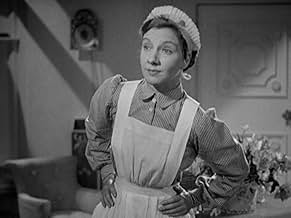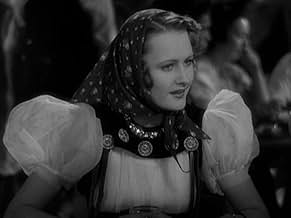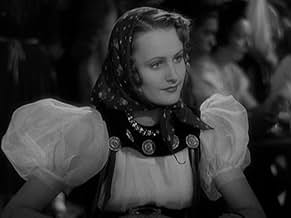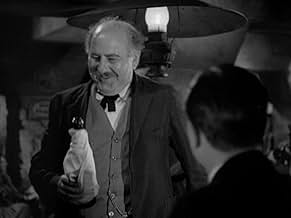IMDb RATING
6.3/10
1.3K
YOUR RATING
A lounge singer is sent by a count to pose as a wealthy socialite.A lounge singer is sent by a count to pose as a wealthy socialite.A lounge singer is sent by a count to pose as a wealthy socialite.
Mary Philips
- Maria
- (as Mary Phillips)
Rafael Alcayde
- Hotel Clerk
- (uncredited)
Nino Bellini
- Cosmos Club Waiter
- (uncredited)
Agostino Borgato
- Cordellera Bar Waiter
- (uncredited)
Adriana Caselotti
- First Peasant Girl
- (uncredited)
Robert Cauterio
- Hotel Clerk
- (uncredited)
Irene Coleman
- Cosmos Club Hat Check Girl
- (uncredited)
Gino Corrado
- Cosmos Club Croupier
- (uncredited)
Featured reviews
The Bride Wore Red is based on an unpublished Ferenc Molnar play which he probably couldn't get anyone on Broadway interested in. So for a reduced rate he sold the property to MGM which gave it the usual lavish MGM treatment.
American accents which bothered some other reviewers didn't bother me. Sometimes they stand out, sometimes they don't. In this case Joan Crawford was cast in a role she played dozens of times before as the poor girl given a chance at riches and does she grab.
This variation on the Pygmalion theme starts in a café in Trieste where Crawford sings and presumably will do other things for her supper. It's in the red light district of Trieste. Count George Zucco hires her on a whim to prove that clothes and manner do make the individual. Zucco showers Crawford with a new wardrobe giving her the chance to show off those Adrian gowns and gives her two weeks at a resort in the Tyrol where the high society pleasures itself.
To make this last though Crawford has to land a husband and she lands on Robert Young. But he's slightly engaged to Lynne Carver, a sweet young thing. They're traveling with friends Reginald Owen who is a foxy old rogue and married to Billie Burke who has to watch the fox like a hawk.
The local postman Franchot Tone is interested in her, but Crawford figures to do better than him. Her only friend is a former café colleague in Mary Phillips who is working as a maid in that hotel. Though the experiment is Pygmalion like, Crawford feels more like Cinderella with the clock inevitably ticking towards midnight.
I think you can probably figure out where this all ends if you're any kind of film fan and Crawford fan. Dorothy Arzner's direction sharpens the character that Crawford created in Grand Hotel as an anxious to rise stenographer taking her couple of steps lower in society and seeing if she can make the climb.
Franchot Tone who was married to Joan Crawford at the time got a break of sorts in this film. Normally he'd be the society guy who Crawford is trying for. As the common, but somewhat erudite postman for once he's not in formal wear in a film.
Another surprise is Billie Burke who together with Mary Boland and Spring Byington was busy playing delightful airheads in her film. She's quite serious and quite good, but inevitably went back to being typecast after this film was completed.
The Bride Wore Red will please Joan Crawford fans immensely and this is a most typical example of the kind of character she played in her years at MGM.
American accents which bothered some other reviewers didn't bother me. Sometimes they stand out, sometimes they don't. In this case Joan Crawford was cast in a role she played dozens of times before as the poor girl given a chance at riches and does she grab.
This variation on the Pygmalion theme starts in a café in Trieste where Crawford sings and presumably will do other things for her supper. It's in the red light district of Trieste. Count George Zucco hires her on a whim to prove that clothes and manner do make the individual. Zucco showers Crawford with a new wardrobe giving her the chance to show off those Adrian gowns and gives her two weeks at a resort in the Tyrol where the high society pleasures itself.
To make this last though Crawford has to land a husband and she lands on Robert Young. But he's slightly engaged to Lynne Carver, a sweet young thing. They're traveling with friends Reginald Owen who is a foxy old rogue and married to Billie Burke who has to watch the fox like a hawk.
The local postman Franchot Tone is interested in her, but Crawford figures to do better than him. Her only friend is a former café colleague in Mary Phillips who is working as a maid in that hotel. Though the experiment is Pygmalion like, Crawford feels more like Cinderella with the clock inevitably ticking towards midnight.
I think you can probably figure out where this all ends if you're any kind of film fan and Crawford fan. Dorothy Arzner's direction sharpens the character that Crawford created in Grand Hotel as an anxious to rise stenographer taking her couple of steps lower in society and seeing if she can make the climb.
Franchot Tone who was married to Joan Crawford at the time got a break of sorts in this film. Normally he'd be the society guy who Crawford is trying for. As the common, but somewhat erudite postman for once he's not in formal wear in a film.
Another surprise is Billie Burke who together with Mary Boland and Spring Byington was busy playing delightful airheads in her film. She's quite serious and quite good, but inevitably went back to being typecast after this film was completed.
The Bride Wore Red will please Joan Crawford fans immensely and this is a most typical example of the kind of character she played in her years at MGM.
Jaded club singer Anni Pavlovitch (Joan Crawford) runs into a count who devises a plan to give Anni an opportunity to swing with the swells for two weeks in a rustic Italian vacation spot in the mountains. Anni is totally seduced by the lifestyle and with time running out moves in on Maddelena Monti' s well heeled beau Rudi Pal ( Robert Young) to try an insinuate herself into the jet set lifestyle on a more permanent basis. The local postman Giullio (Franchot Tone) has also taken a shine to Anni offering her an unencumbered down to earth existence in contrast but cynical Anni is tired of the hardscrabble existence preferring pampered materialism instead.
Under the rare oddity of a female studio film director (Dorothy Arzner) Crawford is allowed to stretch with more than satisfying results as she struggles with the conflict of hooking up for love or money. Arzner not only gets some impressive long takes out of Crawford but also softens her standard studio brusqueness with a touching sensitivity as her dream of easy street evaporates before her eyes.
Arzner also gets fine performances out of upper crusts played by Young and a beautifully smug performance from Billie Burke without being condescending to such easy targets. The real surprise though is the sophisticated Franchot Tone as Giullio the country postman. Playing it neither broad or passionate Tone subversively bides his time with a dignity and patience that gives The Bride Wore Red a nice subtle edge and a more touching denouement.
Under the rare oddity of a female studio film director (Dorothy Arzner) Crawford is allowed to stretch with more than satisfying results as she struggles with the conflict of hooking up for love or money. Arzner not only gets some impressive long takes out of Crawford but also softens her standard studio brusqueness with a touching sensitivity as her dream of easy street evaporates before her eyes.
Arzner also gets fine performances out of upper crusts played by Young and a beautifully smug performance from Billie Burke without being condescending to such easy targets. The real surprise though is the sophisticated Franchot Tone as Giullio the country postman. Playing it neither broad or passionate Tone subversively bides his time with a dignity and patience that gives The Bride Wore Red a nice subtle edge and a more touching denouement.
Dorothy Arzner is the director of this film, and though she does not make a lot of films, she usually makes rather substantial ones. This is certainly a substantial one.
The most appealing aspect of this production is the chemistry and loveliness of the couple played on screen by Joan Crawford and Franchot Tone (married in real life). This is not the only film that MGM has costarred them in together, but in this picture, it is easy to see the magic they create.
For his part, Robert Young is a worthy costar. And so is Joan's dazzling dress, referenced in the title. One must not forget to mention the always splendid Billie Burke, directed in several other pictures by Arzner. This time she portrays a real shrew, not her trademark scatterbrained character.
The most appealing aspect of this production is the chemistry and loveliness of the couple played on screen by Joan Crawford and Franchot Tone (married in real life). This is not the only film that MGM has costarred them in together, but in this picture, it is easy to see the magic they create.
For his part, Robert Young is a worthy costar. And so is Joan's dazzling dress, referenced in the title. One must not forget to mention the always splendid Billie Burke, directed in several other pictures by Arzner. This time she portrays a real shrew, not her trademark scatterbrained character.
In about 1980 I saw this film at the UCLA Film Archives in a series presenting Dorothy Arzner directed films. There was a guest speaker at the event who was a personal friend of Arzner's. I don't remember her name, but she was introduced as, among other things, the writer for the script of "Craig's Wife" (1936; starring Rosalind Russell).
She said she was on the set for some of the shooting of "Bride Wore Red," and described how Joan Crawford was completely uncooperative with the director. Originally it was written for Luise Rainer but for some reason she was unavailable. "So they got Joan Crawford who wasn't anything like her," and was not suited for the film in this woman's opinion. While she was on the set she witnessed how Dorothy Arzner would gently make suggestions as to how to play a scene, "...and Joan would scream, 'You'll destroy me! You'll destroy me!' and she would run up to L.B. Mayer and he would say, 'There, there Joan, play it your way." So she did, "...and frankly, the film bombed. But when you have a star that is entirely uncooperative, you can't blame the director." I hope I have quoted this woman accurately. That is what has stuck in my memory. I am a big Crawford fan, but her flaws were apparently spectacular. I just thought it would be interesting to record this bit of info.
She said she was on the set for some of the shooting of "Bride Wore Red," and described how Joan Crawford was completely uncooperative with the director. Originally it was written for Luise Rainer but for some reason she was unavailable. "So they got Joan Crawford who wasn't anything like her," and was not suited for the film in this woman's opinion. While she was on the set she witnessed how Dorothy Arzner would gently make suggestions as to how to play a scene, "...and Joan would scream, 'You'll destroy me! You'll destroy me!' and she would run up to L.B. Mayer and he would say, 'There, there Joan, play it your way." So she did, "...and frankly, the film bombed. But when you have a star that is entirely uncooperative, you can't blame the director." I hope I have quoted this woman accurately. That is what has stuck in my memory. I am a big Crawford fan, but her flaws were apparently spectacular. I just thought it would be interesting to record this bit of info.
I've never been a fan of Joan Crawford, so it's always a surprise to find a performance of hers that really wins me over. I liked her in Grand Hotel (as 'Flaemmchen,') and I liked her again, very much, as Anni, the cheap night-club singer masquerading as a lady. Often seen in hard and brittle roles, Crawford has a very different look in this film, and expresses a vulnerability that brings her character to life. (Billie Burke is also notable, in the small but juicy role of the acid-tongued Contessa. And Franchot Tone has never been more likable.)
The Bride Wore Red is certainly built according to studio formula, but it also embodies all the earnest craftsmanship that characterized the studio system. The film at times seems clichéd, but it fully redeems itself through genuine empathy for the characters. And through its very strong premise: a 'scarlet' woman driven by hunger for the good life, who is given a slim chance of joining the upper class - provided she's cold and deceitful enough.
Until the final act, I really felt that the film could have gone either way: warm-hearted romance or bitter tragedy. The delicate balancing act makes it hard to achieve a satisfying pay-off. But the ending does succeed, thanks to a couple of nicely orchestrated scenes, and to the talent and charisma of Ms Crawford. These do make us believe that Anni could only choose as she does.
I was a bit sorry the film didn't delve just a little deeper into the moral and social dimensions. Anni's real problem is not what she wants, but rather what she may have to give up in order to get it. That distinction is not made entirely clear, leaving the film a bit too reliant on the old cliché that 'wealth doesn't bring true happiness.' But there's more going on here. Anni's 'tragic flaw' is not the hunger itself, but her willingness to give up honesty, morality and even true love. This distinction becomes almost subliminal, but it's there, and gives the film a slightly sharper edge. Anni is a character we can identify with and possibly admire, even when she's doing something despicable.
If you're in the mood for a traditional, old-style Hollywood entertainment, you won't go wrong with The Bride Wore Red. This is one of the good ones, a film I'd gladly watch again any time.
The Bride Wore Red is certainly built according to studio formula, but it also embodies all the earnest craftsmanship that characterized the studio system. The film at times seems clichéd, but it fully redeems itself through genuine empathy for the characters. And through its very strong premise: a 'scarlet' woman driven by hunger for the good life, who is given a slim chance of joining the upper class - provided she's cold and deceitful enough.
Until the final act, I really felt that the film could have gone either way: warm-hearted romance or bitter tragedy. The delicate balancing act makes it hard to achieve a satisfying pay-off. But the ending does succeed, thanks to a couple of nicely orchestrated scenes, and to the talent and charisma of Ms Crawford. These do make us believe that Anni could only choose as she does.
I was a bit sorry the film didn't delve just a little deeper into the moral and social dimensions. Anni's real problem is not what she wants, but rather what she may have to give up in order to get it. That distinction is not made entirely clear, leaving the film a bit too reliant on the old cliché that 'wealth doesn't bring true happiness.' But there's more going on here. Anni's 'tragic flaw' is not the hunger itself, but her willingness to give up honesty, morality and even true love. This distinction becomes almost subliminal, but it's there, and gives the film a slightly sharper edge. Anni is a character we can identify with and possibly admire, even when she's doing something despicable.
If you're in the mood for a traditional, old-style Hollywood entertainment, you won't go wrong with The Bride Wore Red. This is one of the good ones, a film I'd gladly watch again any time.
Did you know
- TriviaDuring filming, an electrician fell from the catwalk high above the set, narrowly missing the film's star, Joan Crawford. Shooting was temporarily halted while the man was rushed to hospital. Crawford refused to resume production until she was assured that the man would be fully cared for, that he would remain on salary, and that his family would be provided for. Crawford also called the hospital each day afterwards for reports on his condition.
- Quotes
Rudolph 'Rudi' Pal: In my opinion, most people prefer sardines to caviar because most people haven't tried caviar.
- Crazy creditsDuring the opening credits, a music box is shown playing a tune in the background.
- ConnectionsFeatured in The Romance of Celluloid (1937)
- SoundtracksWho Wants Love?
(1937)
Music by Franz Waxman
Lyrics by Gus Kahn
Sung by Joan Crawford (uncredited) at the Cordellera Bar
Played throughout as part of the score
- How long is The Bride Wore Red?Powered by Alexa
Details
- Release date
- Country of origin
- Language
- Also known as
- The Bride Wore Red
- Filming locations
- Austria(Alpine exteriors)
- Production company
- See more company credits at IMDbPro
Box office
- Budget
- $960,000 (estimated)
- Runtime
- 1h 43m(103 min)
- Color
- Aspect ratio
- 1.37 : 1
Contribute to this page
Suggest an edit or add missing content




































